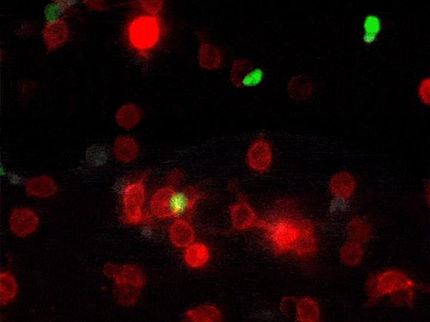Deciphering how CD4 T cells die during HIV infection
Advertisement
Scientists at Gladstone Institute of virology and immunology have solved a long-standing mystery about HIV infection–namely how HIV promotes the death of CD4 T cells. It is the loss of this critical subset of immune cells that leads to the development of AIDS. Most immune cells that die during HIV infection are seemingly not infected, a phenomenon formerly described as "bystander cell killing." Now the Gladstone scientists report that these "bystander" cells are actually the victims of a failed or abortive form of viral infection. Their findings are published in Cel .
Dr. Gilad Doitsh, who performed many of the studies and is the lead author of the paper stated, "Our study reveals that the virus actually enters the CD4 T cells that are destined to die and that the virus starts to make a DNA copy of its RNA, a process called reverse transcription. However, this process does not work well in the majority of these cells and the incomplete DNA intermediates that accumulate in the cytoplasm are sensed and trigger the cells to 'commit suicide' in an attempt to protect the body."
The researchers identified the precise step in which the CD4 T cells die by using different anti-HIV drugs to arrest the virus at different points in its life cycle. Drugs that blocked viral entry or that blocked the start of reverse transcription stopped the killing. Conversely, drugs that acted later in the life cycle did not. Importantly, the researchers used primary human lymphoid tissues, such as tonsil and spleen to uncover this death pathway. These and other lymphoid tissues contain over 98% of the body's CD4 T cells and represent the major site where the virus reproduces itself.
The team also found that the dying cells do not go silently into the night. As they die, these cells release proteins, called cytokines, that cause inflammation and that attract healthy cellular targets promoting repeated rounds of infection and cell death. Scientists have long been interested in why HIV infection and inflammation seem to go hand in hand. This study reveals a new mechanism linking the virus to inflammation.
"Our findings have revealed a completely unexpected mechanism for CD4 T-cell death during HIV infection" said Warner C. Greene, institute director and senior author of the paper. "These results highlight how a natural cellular defense normally used by the host to repel foreign invaders goes awry in HIV infection, resulting in a profound depletion of CD4 T cells. If untreated, this process ultimately causes AIDS."
Most read news
Other news from the department science

Get the life science industry in your inbox
By submitting this form you agree that LUMITOS AG will send you the newsletter(s) selected above by email. Your data will not be passed on to third parties. Your data will be stored and processed in accordance with our data protection regulations. LUMITOS may contact you by email for the purpose of advertising or market and opinion surveys. You can revoke your consent at any time without giving reasons to LUMITOS AG, Ernst-Augustin-Str. 2, 12489 Berlin, Germany or by e-mail at revoke@lumitos.com with effect for the future. In addition, each email contains a link to unsubscribe from the corresponding newsletter.


























































